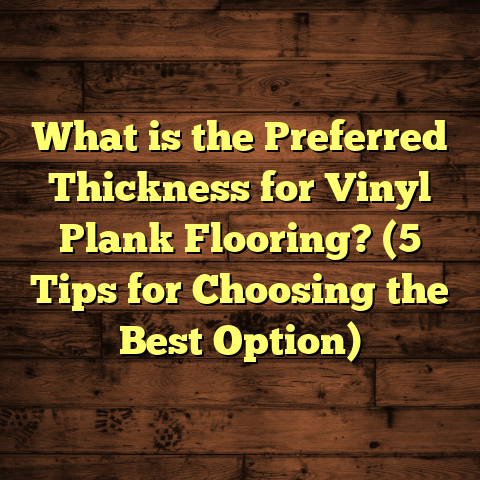What is an Air Floor vs. Aluminum Floor? (5 Key Comparisons)
I remember standing on a nearly finished floor once, hesitating as I pondered whether to recommend an air floor or an aluminum floor to my client. It wasn’t just about materials—it was about the entire experience, from installation to daily use, and even the long-term costs. Over the years, those moments have taught me that understanding these two flooring options deeply is essential before making a choice. Let me take you through the ins and outs of air floors and aluminum floors across five key comparisons, sharing what I’ve learned from real projects, data-backed insights, and a few personal stories along the way.
What is an Air Floor vs. Aluminum Floor?
Before we jump in, it’s good to understand what these terms really mean.
Air floors are flooring systems that incorporate air chambers or layers filled with air. The idea is simple but clever: by trapping air within the structure of the floor, these systems provide benefits like thermal insulation and shock absorption. Air floors aren’t usually a single type of product; rather, they’re a category that includes various designs—from inflatable gym mats to modular panels with built-in air pockets. The common thread is the use of air as part of the floor’s structure to improve comfort and performance.
On the flip side, aluminum floors refer to flooring made primarily from aluminum metal or alloys. Aluminum is known for being lightweight yet strong and resistant to corrosion. Aluminum flooring is often used in industrial settings, portable temporary floors (like stages or walkways), and sometimes in residential or commercial spaces where durability and weight savings are important.
In my work, I’ve seen these two options serve very different needs but sometimes overlap depending on design goals.
1. Material Composition and Weight
Why Material Matters More Than You Think
When clients ask me about air versus aluminum floors, one of their first questions is always about weight and materials. This makes sense because weight affects everything from ease of installation to structural support and shipping costs.
Air Floors:
Air floors are mostly made with polymers, synthetic rubbers, or composites designed to trap air in pockets or chambers. Some systems use inflatable bladders sandwiched between layers of durable fabric or vinyl. Others use foam layers designed with tiny sealed air bubbles.
Here’s something interesting: air itself weighs practically nothing—about 1.225 kg per cubic meter at sea level. So when you trap air inside a floor panel, you’re drastically reducing the overall weight compared to solid materials. This means many air floor panels weigh less than 2 pounds per square foot, making them very manageable for installation.
For example, a client I worked with who was renovating a gym appreciated how quickly we could lay down modular air floor tiles without heavy machinery or extra labor.
Aluminum Floors:
Aluminum floors consist of panels or sheets made from aluminum alloys. Aluminum has a density around 2.7 grams per cubic centimeter, which is about one-third the weight of steel but still significantly heavier than air-filled materials.
Even so, aluminum is considered lightweight for metal flooring. For comparison:
- Steel weighs about 7.85 g/cm³
- Aluminum weighs about 2.7 g/cm³
In a warehouse project where weight limits for flooring were strict due to subfloor constraints, switching from steel to aluminum panels reduced total panel weight by nearly 40%—a huge relief for structural engineers.
Personal Experience: The Weight Debate
I remember once helping a school install new flooring in a multi-purpose room. The existing subfloor couldn’t handle heavy loads well. We proposed an air floor system with inflatable panels that weighed less than half of traditional plywood or aluminum options.
The client was amazed at how quickly we installed it—just a few hours for over 1,000 square feet—and how light it felt underfoot without compromising on stability.
How Weight Affects Your Flooring Choice
- Lightweight needs? Air floors are hard to beat.
- Structural strength but still lighter than steel? Aluminum floors offer a solid middle ground.
2. Durability and Longevity
How Long Will Your Floor Last?
Durability is a key factor when choosing flooring material—you don’t want to replace it after a couple of years.
Air Floors:
Air floors excel in comfort but can be prone to wear and tear depending on construction quality. Inflatable panels especially require careful maintenance to avoid punctures or leaks that compromise performance.
In some athletic facilities I’ve visited, inflatable air floors performed well for years but eventually developed slow leaks that needed patching. The good news is many manufacturers design repair kits for this reason.
Foam-based air floors tend to last longer because they have no risk of deflation but may compress over time losing some cushioning ability.
Aluminum Floors:
Aluminum floors stand out for their durability. Aluminum’s natural resistance to corrosion means these floors can last decades even when exposed to moisture, chemicals, or heavy traffic.
In industrial environments where forklifts or heavy machinery operate daily, aluminum floors hold up remarkably well without dents or rust.
A case study I once reviewed showed aluminum flooring in a factory remained serviceable after over 15 years with minimal maintenance—something steel or wood alternatives struggled with.
Real-Life Example: The Outdoor Deck
One homeowner wanted a deck floor that could survive coastal salt spray without constant repainting or replacement. We installed aluminum decking panels instead of wood or composite options. After seven years, the aluminum deck showed almost no signs of corrosion or fading—proving its worth in harsh conditions.
Durability Summary
- If you want long-lasting, tough flooring for heavy use—aluminum wins.
- For softer, more forgiving surfaces with some maintenance—air floors can work well.
3. Thermal Properties and Comfort
How Does Your Floor Feel?
Comfort underfoot and thermal insulation are often overlooked factors but can dramatically affect how enjoyable your space feels.
Air Floors:
Air floors trap pockets of air which act as natural insulators. This means they reduce heat transfer between your feet and the ground beneath—keeping rooms warmer in winter and cooler in summer.
I worked on a home renovation in a northern city where installing an air floor over concrete slab cut heating bills by about 15% during cold months thanks to better insulation.
Beyond temperature control, air floors also provide excellent shock absorption because the air cushions impact forces. For sports facilities or children’s play areas I’ve installed, this cushioning helped reduce injuries from falls.
Aluminum Floors:
Aluminum conducts heat very efficiently, which can be a double-edged sword. On one hand, it can feel cold underfoot in cooler weather if not paired with insulation underneath; on the other hand, this makes aluminum ideal for radiant heating systems where heat must spread evenly across surfaces.
In one project involving radiant floor heating in a commercial building lobby, aluminum panels ensured uniform heat distribution—making the space comfortable while saving energy by reducing hot spots.
Personal Story: Comfort Challenges
I once installed an aluminum floor in a warehouse without considering thermal comfort fully—the floor felt cold and hard on employees’ feet during winter shifts. Adding anti-fatigue mats helped but was an extra expense that could have been avoided by thinking through thermal properties earlier.
Thermal Takeaway
- Want warmth and cushioning? Air floors deliver.
- Need efficient heat spreading for underfloor heating? Aluminum is your pick.
4. Installation Process and Flexibility
How Hard Is It to Put These Floors Down?
Installation time and complexity can heavily influence costs and project timelines.
Air Floors:
Many air floor systems come as modular tiles or rolls that can be laid quickly without heavy tools or specialized skills. Some inflatable systems require pumps to fill chambers onsite—this adds steps but allows precise control over firmness and leveling.
For DIYers or fast-turnaround projects I’ve been involved with, air floors often reduce labor costs and downtime significantly.
Aluminum Floors:
Aluminum flooring installation demands more precision. Panels must be cut accurately and fastened securely using screws, clips, or adhesives to prevent movement or rattling.
Handling aluminum sheets requires care to avoid bending or scratching during installation. In my experience managing teams installing hundreds of square feet of aluminum flooring for manufacturing plants, training workers thoroughly upfront reduced mistakes and rework dramatically.
Example From the Field
On one tight-deadline project installing aluminum flooring in an airport hangar, our team used pre-cut panels designed for interlocking assembly. This sped up installation by nearly 25% compared to traditional sheet metal work.
Installation Summary
- Want quick setup with minimal tools? Air floors are easier.
- Need rugged flooring installed precisely? Aluminum requires more planning but offers strong results.
5. Cost Efficiency Over Time
How Much Will It Really Cost?
Everyone wants to know: what’s the real cost?
Air Floors:
Air floors can be inexpensive upfront if you choose simpler inflatable mats or basic foam panels. However, costs can add up through maintenance—patching leaks or replacing worn sections over time may be necessary.
Prices vary widely by product type; simple inflatable gym mats might start at around $5-$10 per square foot, while advanced modular air floors with layered construction can reach upwards of $15-$20 per square foot.
Aluminum Floors:
Aluminum floors usually have higher initial costs—typically around $15-$30 per square foot, depending on thickness, finish, and fabrication complexity.
Despite that, their durability means fewer repairs or replacements over time. A case study from an industrial client showed aluminum flooring saved them about 30% in total lifetime costs compared to cheaper alternatives due to reduced downtime and repair bills.
Personal Insight: Budgeting Realities
One client initially balked at aluminum floor prices but later told me it was worth every penny when they avoided disruptions caused by damaged flooring over several years.
If budget constraints are tight but durability matters, consider phased installations combining temporary air floor sections with permanent aluminum zones.
Additional Considerations That Shaped My Choices
When advising clients on these two options, I often consider:
- Environmental Impact:
Aluminum is recyclable and often made with recycled content, making it eco-friendly if sourced responsibly. Air floors depend heavily on plastic polymers, which may pose disposal challenges, though some manufacturers now offer recyclable versions. - Acoustic Properties:
Air floors absorb sound better due to trapped air layers, reducing noise transmission in multi-story buildings. Aluminum floors tend to reflect sound, which might require additional soundproofing. - Aesthetic Versatility:
Air floors come in various colors and textures, making them popular where design matters. Aluminum floors usually offer metallic finishes, sometimes anodized or painted, providing modern industrial looks. - Safety Features:
Air floors’ cushioning reduces injury risk. Aluminum floors can be treated with non-slip coatings but remain firmer underfoot.
Comparing Air Floors & Aluminum Floors With Other Options
I often get asked how these two compare with other common flooring types:
- Wood Flooring:
Warm and natural but heavy and susceptible to moisture damage. Aluminum beats wood on durability; air floors win on comfort. - Laminate Flooring:
Affordable with decent looks but lacks insulation. Air floors outperform laminate in comfort; aluminum outlasts laminate in tough settings. - Concrete:
Extremely durable but cold and hard. Aluminum offers lighter-weight durability; air floors provide better insulation. - Vinyl Flooring:
Comfortable and waterproof but less durable than aluminum. Air floors may offer comparable comfort but better thermal properties than vinyl alone.
My Final Thoughts
After spending years working hands-on with both air floors and aluminum floors, the choice boils down to your specific needs:
- For spaces requiring light weight, comfort, and insulation, I lean towards air floors.
- For places demanding strength, long life, resistance to harsh conditions, aluminum floors are unbeatable.
Sometimes mixing elements from both gives the best solution—for example, an industrial site using aluminum panels topped with cushioned air mats creates a durable yet user-friendly floor system.
Have you tried either type yourself? What surprised you most? Flooring choices shape our daily lives more than we realize—getting it right pays off in comfort, cost savings, and peace of mind for years ahead.





